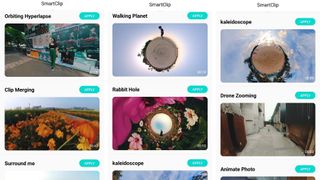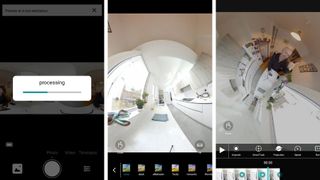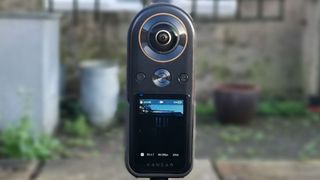8K video in a consumer 360 camera? It might sound like a vision of the future, but Hong Kong-based Kandao’s QooCam 8K (US$589/UK£529/AUS$940) is here to change everything you know about 360 cameras.
Can it create virtual reality (VR)-grade video? Sure, but it’s big advantage over its rivals – the GoPro Max and the Insta360 One X – is that it allows 360-degree footage to be cut down to widescreen size without a horrendous loss in resolution.
There are downsides to this added power – including the Qoocam 8K’s size, price and lack of native waterproofing – but if you’re prepared to compromise on those features, it more than gives the GoPro Max a run for its money.
Design and build
- Weighs 228g, way more than most 360 cameras
- ‘Invisible’ selfie stick mode
- Not waterproof
There’s no getting away from the fact that the QooCam 8K is much larger than its 360 camera rivals.
At 144x56x23mm and 228g, it’s significantly bigger and more cumbersome. Inside is a large 3,000mAh built-in battery that has to work hard when the QooCam 8K is switched on. You can hear its processor buzzing away constantly.
On both sides of the camera is a fisheye lens with f/2.0 aperture. One side hosts that OLED touchscreen, with the edges bearing a microSD card slot, a USB-C slot for recharging, and an output for attaching a microphone – on a 360 camera where the action may be taking place a long way from the camera, that’s key.
Also included in the box is a ‘bumper’-style protective style case. That’s useful because the QooCam 8K is not natively drop-proof or waterproof. Also available is a waterproof case, which is an underwater housing for scuba diving.
An essential add-on is Kandao’s ‘invisible’ selfie stick (US$35/UK£30/AUS$50), which comes complete with a small, spider-style tripod. It’s a must-have if you want to take advantage of the QooCam 8K for vlogger-style video.
Features
- Records video in 8K 30fps resolution
- Slo-mo in 4K 120fps
- SuperSteady image stabilisation
The QooCam 8K does a lot of things that other 360 cameras don’t. The first is obvious; it captures 8K video at 30fps and takes photos – in JPEG and the Raw format DNG – in 29.4MP thanks to its two 1/1.7-inch CMOS sensors.
That’s 7680×3840 pixels, though note that the extra resolution – while impressive – is spread throughout a 360-degree sphere. Its purpose is to increase the resolution of 360 video, of course, but in practice it enables filmmakers to video everything and re-frame in widescreen later without losing sharpness. Just as importantly, its big sensors mean more light and dynamic range.
It can also shoot in a 4K/120 fps mode, which produces super-slo mo videos. All videos can be captured in 8-bit MP4 (H.264) and 10-bit ProRes formats.
Yet another advantage over other most 360 cameras is its 2.4-inch color OLED touchscreen, which gives real-time previews of photos and videos (though that can also be done via the QooCam app). It’s also got 64GB of built-in storage in addition to a microSD card slot (up to 256GB).
Performance
- Excellent quality video and photos
- OLED screen aids composition
- Effective image stabilization
The photos and videos coming out of the QooCam 8K are unequalled by any other consumer-grade 360 camera.
Resolutions are limited to just two choices: 8K at 30fps and 4K at 120 fps mode for slo-mo. The results from both are sharp and imbued with plenty of dynamic contrast and color.
Would we like more choices of resolutions? Yes, plus there’s no easy way to reverse the slo-mo effect in 4K mode, which is a shame. However, we have no complaints about the extra resolution on offer, which vastly improves the quality of widescreen photos and videos cut-down from the 360 master.
Powered by a built-in six-axis gyro, QooCam’s ‘SuperSteady’ image stabilization works wonders and it’s easy to produce smooth-looking vlogger-style videos using the selfie stick. The stick’s use is automatically detected and it thus vanishes from the finished videos and photos.
A slight issue is processing power; the QooCam 8K’s processor is hungry, and despite having a large internal battery, it lasts little more than an hour. If you’re out for a day shooting and using it only occasionally, practically speaking, that’s about enough. As a bonus, its internal battery can be recharged via USB-C from a portable battery, so longer shoots are possible.
App and editing
- ‘4K Express Edit’ helps workflow
- Large files slow to transfer to phone
- ‘SmartClip’ templates lack intelligence
Editing 8K video files on a phone? It might not sound fun, but luckily the QooCam 8K includes a nifty ‘4K Express Edit’, which downscales everything for much easier workflow. Easier, yes, but not particularly quick.
In the box are a bunch of cables to hook the QooCam 8K up to a variety of phones, though unless you have one of the latest phones with a big processor, you may encounter problems. Our Huawei Mate 20 X (5G) did fine, but transferring the files even via a cable proved slow work.
The mostly impressive QooCam app enables some pretty comprehensive editing options, including ‘SmartTrack’ for keeping a subject in the middle of the frame. There are also options to trim videos, use various filters, and add music. Its long list of ‘SmartClip’ templates are initially tempting.
Templates like ‘Orbiting Hyperlapse’, ‘Surround Me’, ‘Rabbit Hole’, ‘Dolly Zoom’ and even a basic ‘Clip Merging’ each come with a short tutorial and suggest that creating polished-looking novelty 360 videos – all as shareable widescreen videos – is very easy.
In practice, even when we followed the tutorials, some of the templates did little more than kick-in manual editing mode. It’s also very challenging to see which video clips in a library might be suitable for the various templates. However, producing short, edited videos in manual mode is not particularly difficult.
Verdict
Does the QooCam 8K trump the GoPro Max, GoPro Fusion, Insta360 One X and Insta360 One R? Yes, absolutely; once you’ve filmed 360 footage in 8K resolution, it’s impossible to go back.
The downside is that it’s not as convenient as any of those much smaller, niftier cameras, but 8K resolution gives you so much more quality to play with when editing.
It’s the first 360 camera where cut-down widescreen videos retain enough resolution to look good, and it does all that with excellent dynamic range, color and contrast for 8K photos as well as videos.
The QooCam 8K is not perfect, but in the 360 video niche, the ante just got upped.










